An Artificial Magnetic Conductor-Based Wideband Circularly Polarized Antenna with Low-Profile and Enhanced Gain
Abstract
:1. Introduction
2. Antenna Design
2.1. Impedance Matching
2.2. Evolution of the Dipole
2.3. AMC Design
2.4. Key Parameter Study
3. Simulation and Measurement Results
- i.
- ii.
- iii.
4. Conclusions
Author Contributions
Funding
Conflicts of Interest
References
- Nasimuddin, N.; Qing, X.; Chen, Z.N. Bandwidth enhancement of a single-feed circularly polarized antenna using a metasurface. IEEE Antennas Propag. Mag. 2016, 58, 39–46. [Google Scholar] [CrossRef]
- Esselle, K.P.; Verma, A.K. Wideband circularly polarized stacked microstrip antennas. IEEE Antennas Wirel. Propag. Lett. 2007, 6, 21–24. [Google Scholar]
- Liu, Q.; Chen, Z.N.; Liu, Y.; Li, C. Compact ultrawideband circularly polarized weakly coupled patch array antenna. IEEE Trans. Antennas Propag. 2017, 65, 2129–2134. [Google Scholar]
- Oraizi, H.; Pazoki, R. Wideband circularly polarized aperture-fed rotated stacked patch antenna. IEEE Trans. Antennas Propag. 2013, 61, 1048–1054. [Google Scholar] [CrossRef]
- Baik, J.W.; Lee, T.H.; Pyo, S.; Han, S.M.; Jeong, J.; Kim, Y.S. Broadband circularly polarized crossed dipole with parasitic loop resonators and its arrays. IEEE Trans. Antennas Wirel. Propag. 2011, 59, 80–87. [Google Scholar] [CrossRef]
- Feng, G.; Chen, L.; Xue, X.; Shi, X. Broadband circularly polarized crossed-dipole antenna with a single asymmetrical cross-loop. IEEE Antennas Wirel. Propag. Lett. 2017, 16, 3184–3187. [Google Scholar] [CrossRef]
- Tran, H.H.; Park, I.; Nguyen, T.K. Circularly polarized bandwidth-enhanced crossed dipole antenna with a simple single parasitic element. IEEE Antennas Wirel. Propag. Lett. 2017, 16, 1776–1779. [Google Scholar] [CrossRef]
- He, Y.; He, W.; Wong, H. A wideband circularly polarized cross-dipole antenna. IEEE Antennas Wirel. Propag. Lett. 2014, 13, 67–70. [Google Scholar]
- Tran, H.H.; Park, I. Wideband circularly polarized cavity-backed asymmetric crossed bowtie dipole antenna. IEEE Antennas Wirel. Propag. Lett. 2016, 15, 358–361. [Google Scholar] [CrossRef]
- Ta, S.X.; Park, I. Crossed dipole loaded with magneto-electric dipole for wideband and wide-beam circularly polarized radiation. IEEE Antennas Wirel. Propag. Lett. 2015, 14, 358–361. [Google Scholar] [CrossRef]
- Zhu, H.; Cheung, S.; Chung, K.L.; Yuk, T.I. Linear-to-circular polarization conversion using metasurface. IEEE Trans. Antennas Propag. 2013, 61, 4615–4623. [Google Scholar] [CrossRef] [Green Version]
- Lin, W.; Chen, S.; Ziolkowski, R.W.; Guo, Y.J. Reconfigurable wideband low-profile circularly polarized antenna and array enabled by an artificial magnetic conductor ground. IEEE Trans. Antennas Propag. 2018, 66, 1564–1569. [Google Scholar] [CrossRef]
- Xin, L.; Jiao, Y.C.; Li, Z. Wideband low-profile CPW-fed slot-loop antenna using an artificial magnetic conductor. Electron. Lett. 2018, 54, 673–674. [Google Scholar]
- Li, R.; Qin, Y.; Li, F.; Wu, L.; Cui, Y. AMC surface based on spiral strips and its applications for low-profile broadband planar antennas. IET Microw. Antennas Propag. 2019, 13, 326–333. [Google Scholar] [CrossRef]
- Li, M.; Li, Q.L.; Wang, B.; Zhou, C.F.; Cheung, S.W. A Low-Profile Dual-Polarized Dipole Antenna Using Wideband AMC Reflector. IEEE Trans. Antennas Propag. 2018, 66, 2610–2615. [Google Scholar] [CrossRef]
- Liu, Q.; Liu, H.; He, W.; He, S. A Low-Profile Dual-Band Dual-Polarized Antenna with an AMC Reflector for 5G Communications. IEEE Access 2020, 8, 24072–24080. [Google Scholar] [CrossRef]
- Ta, S.X.; Park, I.; Ziolkowski, R.W. Circularly polarized crossed dipole on an HIS for 2.4/5.2/5.8-GHz WLAN applications. IEEE Antennas Wirel. Propag. Lett. 2013, 12, 1464–1467. [Google Scholar] [CrossRef]
- Tran, H.H.; Park, I. A dual-wideband circularly polarized antenna using an artificial magnetic conductor. IEEE Antennas Wirel. Propag. Lett. 2016, 15, 950–953. [Google Scholar] [CrossRef]
- Feng, D.; Zhai, H.; Xi, L.; Yang, S.; Zhang, K.; Yang, D. A Broadband Low-profile Circular Polarized Antenna on an AMC Reflector. IEEE Antennas Wirel. Propag. Lett. 2017, 16, 2840–2843. [Google Scholar] [CrossRef]
- Tran, H.H.; Nguyen-Trong, N.; Le, T.T.; Abbosh, A.M.; Park, H.C. Low-profile wideband high-gain reconfigurable antenna with quad-polarization diversity. IEEE Trans. Antennas Propag. 2018, 66, 3741–3746. [Google Scholar] [CrossRef]
- Yang, W.; Che, W.; Jin, H.; Feng, W.; Xue, Q. A polarization-reconfigurable dipole antenna using polarization rotation AMC structure. IEEE Trans. Antenna Propag. 2015, 63, 5305–5315. [Google Scholar] [CrossRef]
- Ding, C.; Jones, B.; Guo, Y.J.; Qin, P.Y. Wideband matching of full-wavelength dipole with reflector for base station. IEEE Trans. Antennas Propag. 2017, 65, 5571–5576. [Google Scholar] [CrossRef]
- Ding, C.; Sun, H.; Zhu, H.; Jay Guo, Y. Achieving wider bandwidth with full-wavelength dipoles for 5G base stations. IEEE Trans. Antennas Propag. 2020, 68, 1119–1127. [Google Scholar] [CrossRef]
- Sun, G.H.; Wong, S.W.; Wong, H. A broadband antenna array using full-wave dipole. IEEE Access 2017, 5, 13054–13061. [Google Scholar] [CrossRef]
- Zhai, H.; Xi, L.; Zang, Y.; Li, L. A Low-Profile Dual-Polarized High-Isolation MIMO Antenna Arrays for Wideband Base-Station Applications. IEEE Trans. Antennas Propag. 2018, 66, 191–202. [Google Scholar] [CrossRef]
- Liu, J.; Li, J.; Yang, J.; Qi, Y.; Xu, R. AMC-Loaded Low-Profile Circularly Polarized Reconfigurable Antenna Array. IEEE Antennas Wirel. Propag. Lett. 2020, 19, 1276–1280. [Google Scholar] [CrossRef]
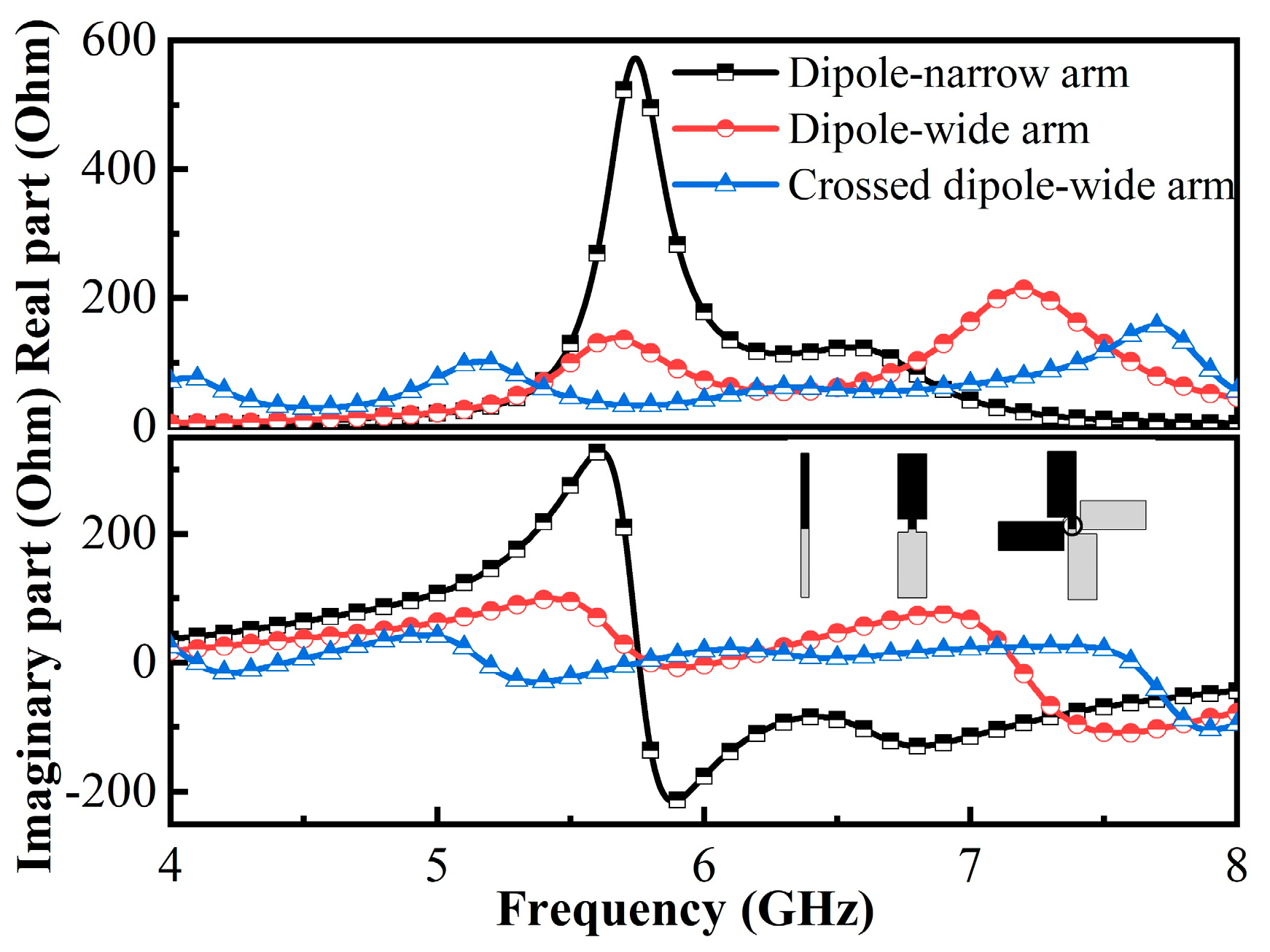




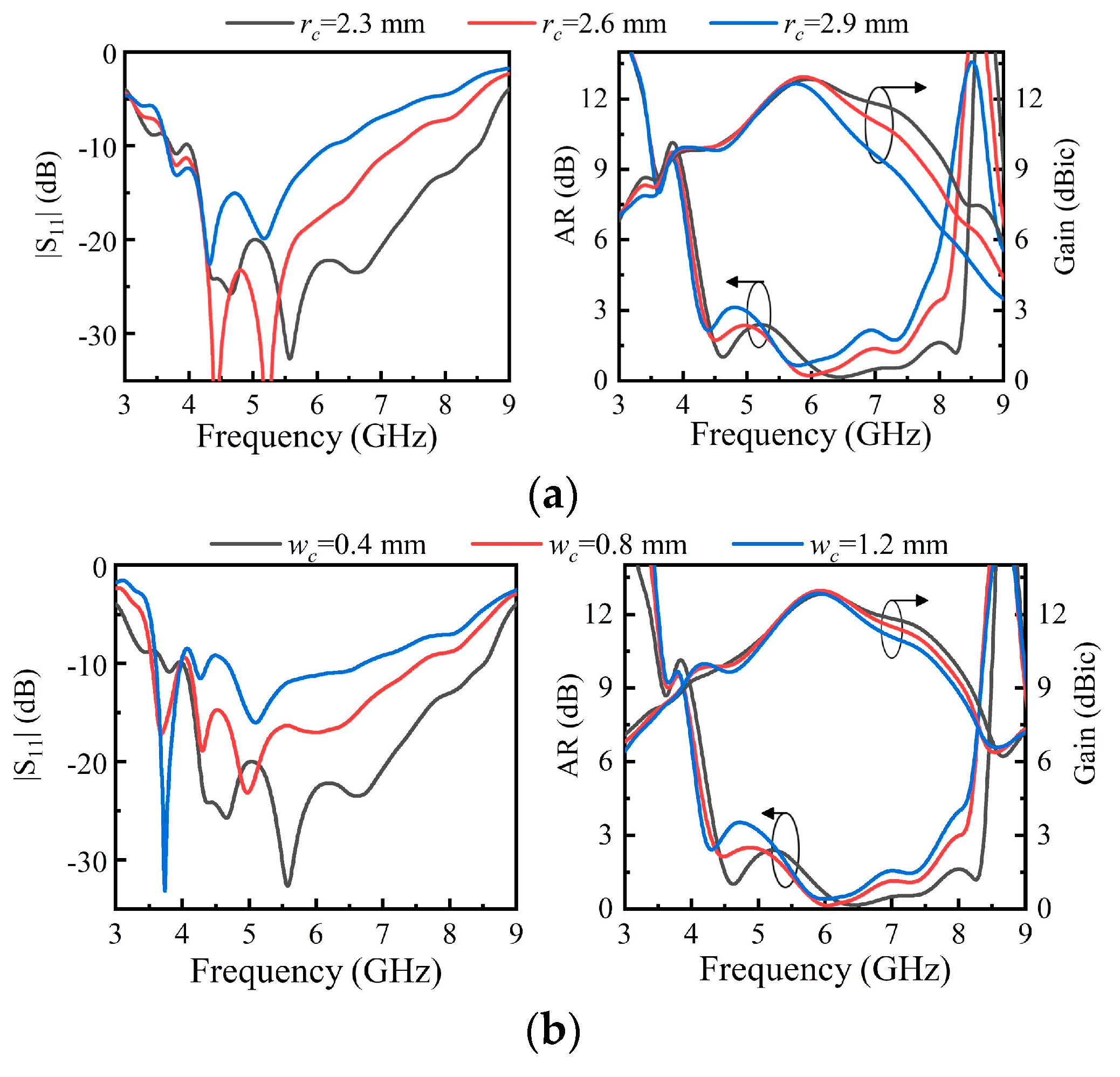
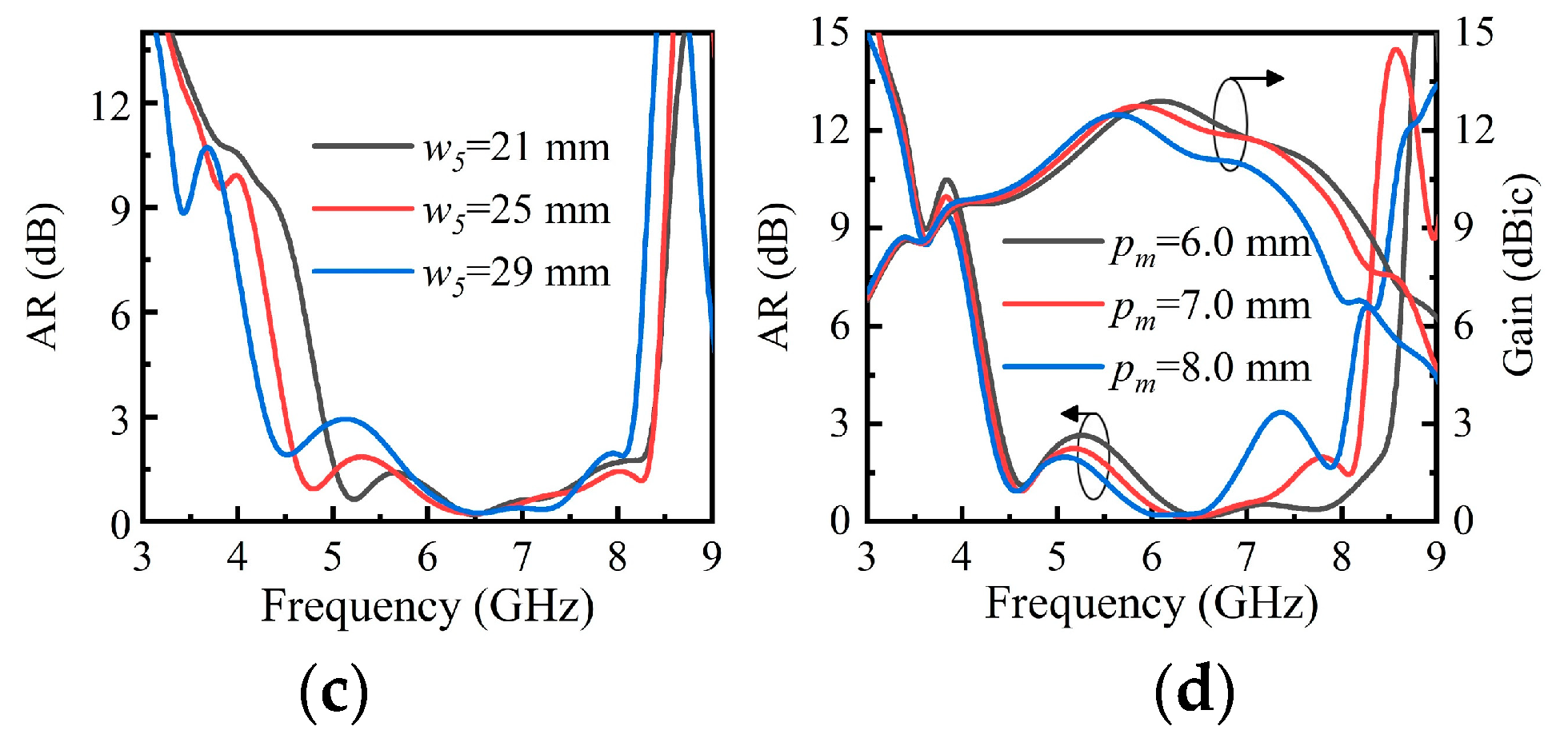

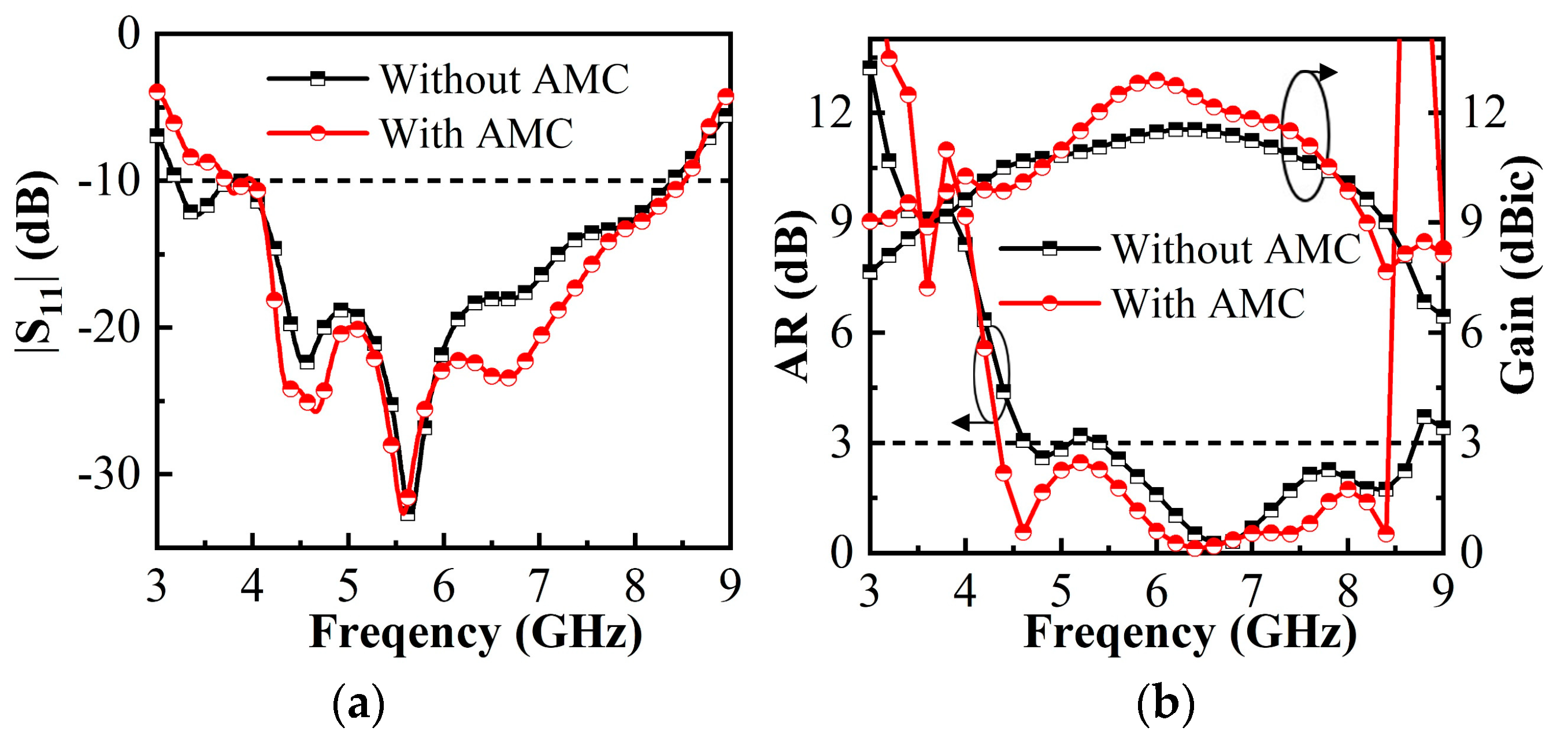
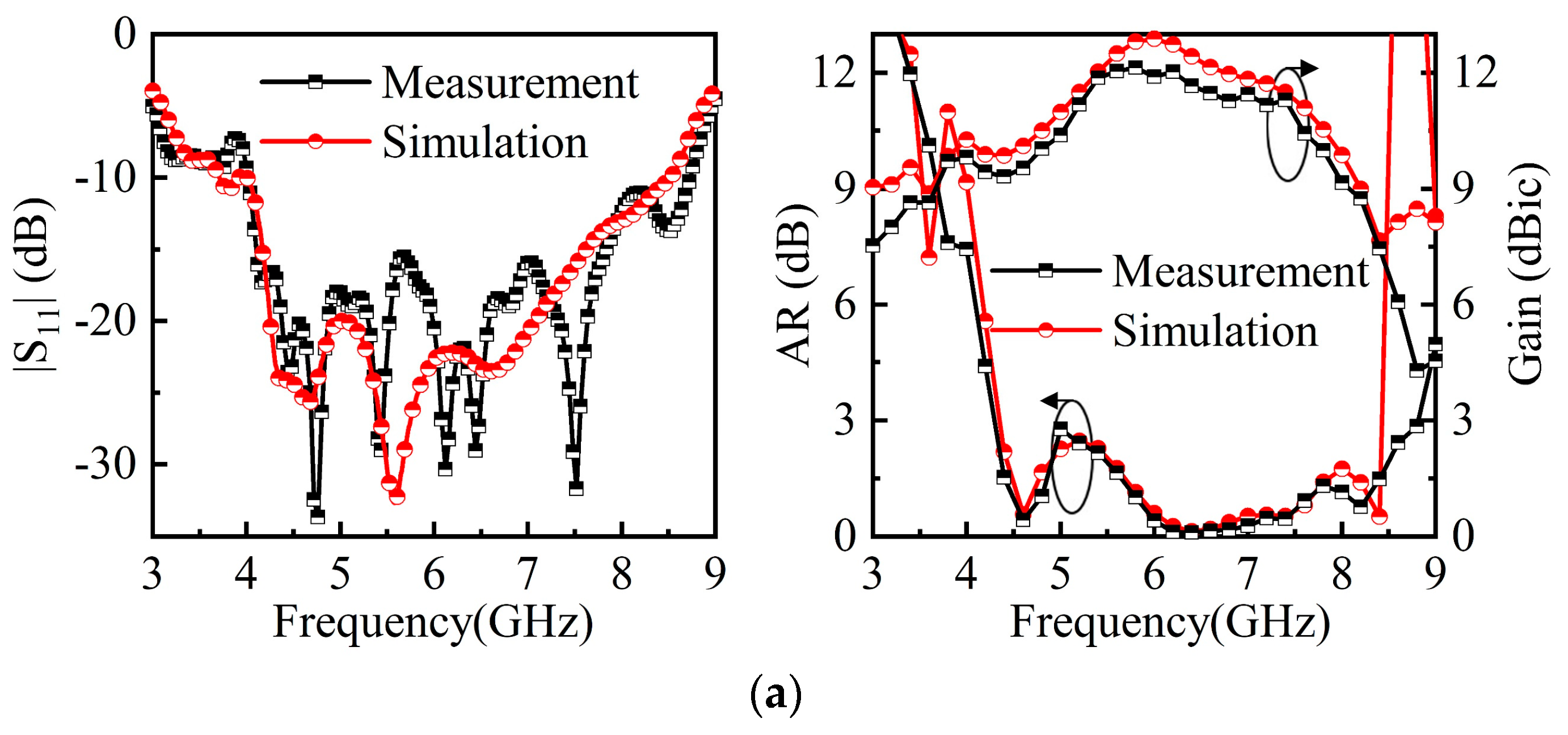

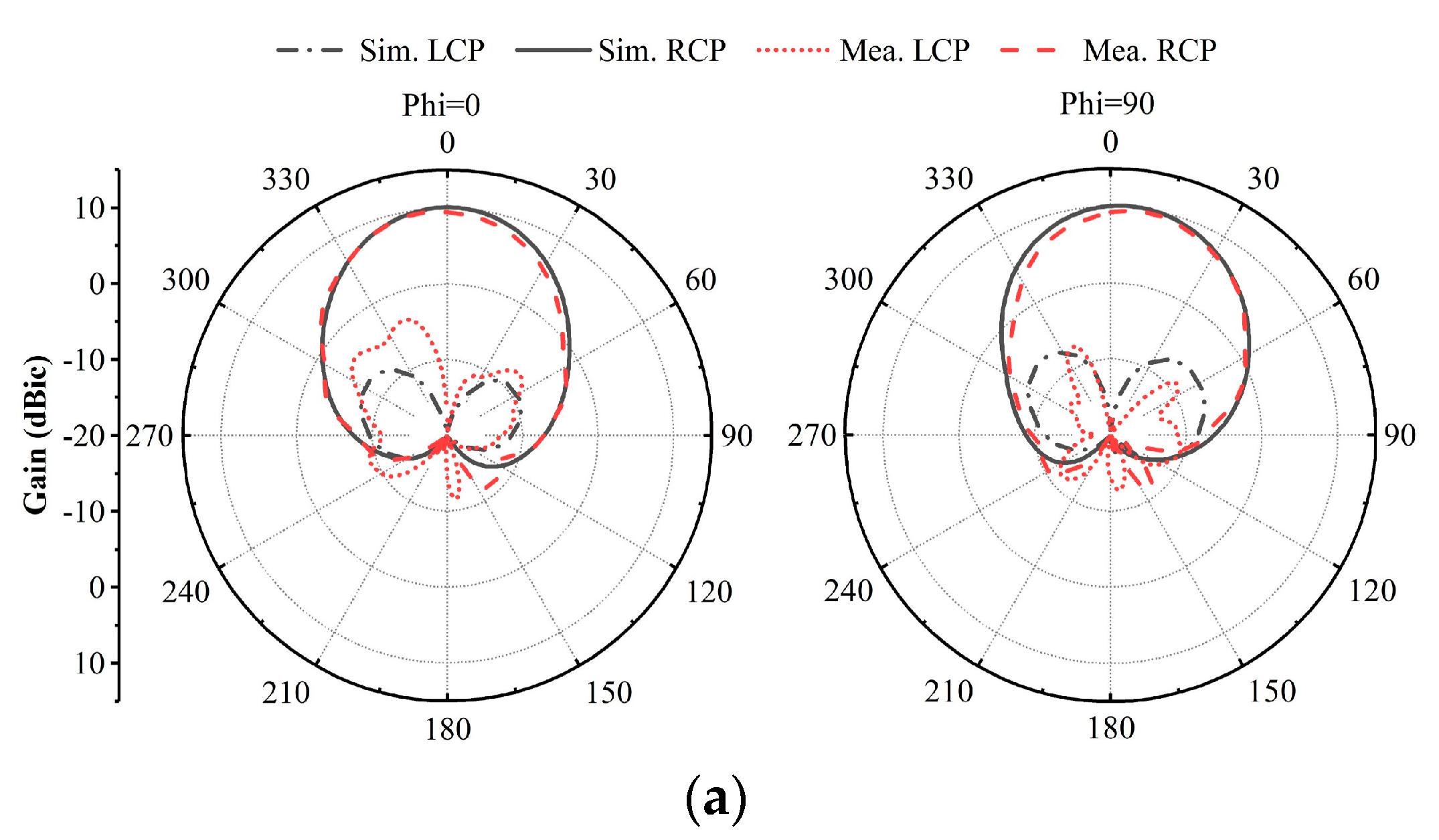

| Ref. | Antenna Type | No. of Elements | IBW (%) | Polarization /ARBW (%) | Average Gain (dBi/dBic) | |
|---|---|---|---|---|---|---|
| [12] | Crossed-dipole with AMC | 1 | 46.2 | CP/26.3 | 5.9 | 0.94 × 0.94 × 0.05 |
| 1×4 | 27.7 | CP/21.7 | 11.3 | 2.83 × 0.94 × 0.05 | ||
| [13] | Slot loop antenna with AMC | 1 | 37.9 | LP | 5.5 | 0.67 × 0.45 × 0.05 |
| [14] | Dipole antenna with AMC | 1 | 42.0 | LP | 8.0 | 1.0 × 1.0 × 0.08 |
| 33.0 | CP/48.0 | 8.0 | ||||
| [15] | Dipole antenna with AMC | 1 | 56.3 | LP | 8.1 | 1.48 × 1.2 × 0.14 |
| 60.1 | LP | 7.4 | ||||
| [16] | Crossed dual-band bowtie dipoles with AMC | 1 | 19.8 | LP | 7.0 | 0.93 × 0.93 × 0.13 |
| 13.2 | LP | 8.1 | ||||
| [18] | Crossed-dipole with AMC | 1 | 49.5 | CP/33.8 | 7.4 | 0.64 × 0.64 × 0.16 |
| [19] | Crossed-dipole with AMC | 1 | 66.3 | CP/44.7 | 5.2 | 1.5 × 1.5 × 0.12 |
| [25] | Crossed-dipole with AMC | 1×4 | 22.3 | LP | 10.2 | 1.01 × 3.28 × 0.11 |
| [26] | Monopole with AMC | 2×4 | 36.5 | CP/21.47 | 15.1 | 3.20 × 0.82 × 0.12 |
| This work | Full-wavelength crossed-dipole with AMC | 1 | 74.0 | CP/67.7 | 10.7 | 1.6 × 1.6 × 0.14 |
Publisher’s Note: MDPI stays neutral with regard to jurisdictional claims in published maps and institutional affiliations. |
© 2021 by the authors. Licensee MDPI, Basel, Switzerland. This article is an open access article distributed under the terms and conditions of the Creative Commons Attribution (CC BY) license (https://creativecommons.org/licenses/by/4.0/).
Share and Cite
Qiu, L.; Xiao, G. An Artificial Magnetic Conductor-Based Wideband Circularly Polarized Antenna with Low-Profile and Enhanced Gain. Electronics 2021, 10, 2121. https://doi.org/10.3390/electronics10172121
Qiu L, Xiao G. An Artificial Magnetic Conductor-Based Wideband Circularly Polarized Antenna with Low-Profile and Enhanced Gain. Electronics. 2021; 10(17):2121. https://doi.org/10.3390/electronics10172121
Chicago/Turabian StyleQiu, Lina, and Gaobiao Xiao. 2021. "An Artificial Magnetic Conductor-Based Wideband Circularly Polarized Antenna with Low-Profile and Enhanced Gain" Electronics 10, no. 17: 2121. https://doi.org/10.3390/electronics10172121






